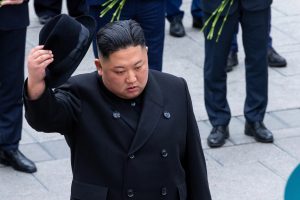Early last month, North Korean leader Kim Jong Un invited an art troupe of Korean boys and girls living in Japan to the headquarters building of the Workers’ Party of Korea (WPK) Central Committee during their visit to Pyongyang, and took some commemorative photos with them. The sight of the young boys and girls shedding tears while singing songs of loyalty in front of Kim was widely reported by North Korean media.
At Kim’s behest, a farewell reception was planned just before their return to Japan, an extraordinary gesture. At the reception, the head of the art troupe said that “the care of Kim Jong Un, who bestows great benevolence, is the one of the great father who brings the dreams and future of the Korean children in Japan into full bloom.” Through this visit, Kim Jong Un’s emphasis on the General Association of Korean Residents in Japan (known as “Chongryon”) has become clearer.
As a result of Japan’s history with Korea, tens of thousands of Koreans live in Japan as “special permanent residents” (known as Zainichi Koreans). Many of these Koreans naturalized after marrying Japanese citizens, and by 2019, there were more Vietnamese nationals living in Japan than Koreans. Although the Mindan (Korean Residents Union, KRU), supporting South Korea, and the Chongryon, which supports North Korea, are rival Zainichi Korean organizations, the latter has long been in the minority. Estimates announced by the Public Security Intelligence Agency in Japan in 2016 put the number of members at around 70,000, and it is thought to have declined further since then.
This is hardly surprising. Openly supporting North Korea while living within a Japanese society that values freedom feels quite discordant. Chongryon operates North Korean schools, from kindergarten to university, where portraits of Kim Il Sung and Kim Jong Un are displayed everywhere, and students are taught in Korean about the magnificence of the Kim family. Since their education diverges from the policies of the Ministry of Education, Culture, Sports, Science, and Technology, these schools are ineligible for economic support from the Japanese government. Even so, Chongryon and the North Korean schools accuse the government of ethnic discrimination.
A large majority of Japanese harbor strong resentment toward North Korea due to the issues of abductions, nuclear weapons, and missiles, and this has created a severely negative perception of Chongryon. Against this backdrop, how would boys and girls, thoroughly indoctrinated at North Korean schools, react to an opportunity to meet the “respected fatherly Marshal” in Pyongyang? Korea Central TV broadcast images of the boys and girls crying tears of joy.
According to North Korean media, while “warmly shaking the hands of the head of the art troupe,” Kim Jong Un requested him “to train a larger number of pillars who would carry forward the baton of the patriotic cause of Chongryon.” These remarks hint that Chongryon is operating its schools amid severe economic difficulties.
Kim’s emphasis on Chongryon is distinct from that of his father and predecessor, Kim Jong Il. In the early years of that Kim’s administration, Chongryon was a priority, as it had been during the administration of his father, Kim Il Sung.
However, missile launches and nuclear tests led the Japanese government to tighten economic sanctions on North Korea, making it difficult for Chongryon to continue sending the large sums of money to Pyongyang it had previously. The messages Kim Jong Il sent to the now-marginalized Chongryon were rather chilly. Kim did not often meet with Chongryon executives when they visited North Korea. Moreover, by this point, rather than expecting funds from the declining Chongryon, North Korea by this time was looking to South Korea and China for economic cooperation.
The organizational decline of Chongryon accelerated in 2002 when Kim Jong Il himself acknowledged the abduction of Japanese citizens and apologized. Up until this point, Chongryon had adhered to North Korea’s stance without question and had claimed that the Japanese government was fabricating the abduction issue. Learning that the homeland they had trusted was responsible for the abduction of Japanese citizens appeared to come as a profound shock.
Economic sanctions have meanwhile banned Chongryon executives from reentering Japan. Once they visit North Korea, they can no longer return to their lives in Japan, effectively making once-frequent trips to Pyongyang impossible. This is why it was the principal of a North Korean school in Kyoto who led the group of Zainichi Korean boys and girls on their visit to Pyongyang.
The situation shifted somewhat when Kim Jong Un assumed power. Although funding from Chongryon could no longer be expected and human interaction between Japan and North Korea had all but halted, Kim consistently shared warm messages with Chongryon and the broader Zainichi Korean community. This could be attributed to the fact that his own beloved mother, Ko Yong Hui, was a former Zainichi Korean from Osaka.
Kim’s clear emphasis on Chongryon could offer the Japanese government an opportunity to move beyond the impasse in North Korean-Japanese relations by making kindergarten and high school education free for North Korean schools. However, this would be a rather difficult path to follow, given that the North Korean schools, Chongryon, and North Korea appear to be deeply intertwined, making it difficult for the government of Prime Minister Ishiba Shigeru to win public support in Japan for efforts to improve the situation for Zainichi Koreans. Even as the warm relationship between Kim and Chongryon is publicly lauded, there seems little prospect for any real change.

































